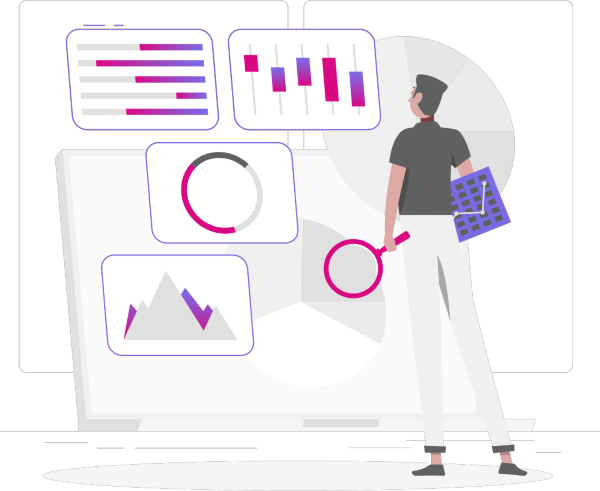Data Extraction Software
10x Faster
With AI
Data Extraction Software
10x Faster With AI


AI-Driven Data Extraction
Real-time Data Updates
Seamless Data Integration
High-Level Accuracy
Anti-Blocking Mechanisms
Customizable Extraction Rules
NO SET-UP COST
NO INFRA COST
NO CODING
4X
Rapid increase of your wealth
30%
Decrease your expenses wisely
1M+
Trusted regular active users
USED BY



Automated Data Extraction Software Makes It Easy To Extract Structured Data From Web Pages
Outsource Big Data‘s intelligent data extraction software can find data quickly, accurately, and within unstructured documents as a human would. Our data extractor extracts data from unstructured medical records, purchase orders, and government documents quickly and accurately. Not only can we extract information automatically, but we can also output the data to a final destination of your organisation’s choosing, allowing for easier search capabilities.
Learn about our innovative data extraction services that add tangible value to your business. Our solutions assist organisations in addressing data challenges and staying ahead of the competition.
What is Data Extraction?
The process of collecting or retrieving disparate types of data from a variety of sources, many of which may be poorly organised or completely unstructured, is known as data extraction. Data extraction allows you to consolidate, process, and refine data so that it can be stored in a centralised location and transformed later. These locations could be on-premises, cloud-based, or a combination of the two.
Working Of Data Extraction Software
Data extraction software collects, extracts, and transforms data from various sources automatically into a structured format that can be easily analysed and used for decision making. Below is the working process of data extractor:

Connect To Data Source
The data extraction software connects to the data source, which can be a database, an API, a website, or any other type of data repository.
Identify Data To Extract
The data extractor determines which data to extract based on user-defined criteria such as specific columns, rows, or tables.
Extract Data
Then the data is extracted from the data source, typically by sending a query or an API request.
Transform Data
Data is transformed into a structured format, such as a spreadsheet or a database table, after
Store Data
Data is then stored in a data storage solution, such as a data warehouse or a data lake, for further analysis and use.
Repeat The Process
To keep the data up to date, the software can be configured to repeat the data extraction process on a regular basis, such as daily or weekly.
Overall, data extraction software automates the process of collecting, transforming, and storing data from a variety of sources, making it easier and more efficient for organisations to gather the information they require for analysis and decision making.
Importance of Data Extraction
Data extraction is crucial for transforming raw data into competitive insights, impacting a company’s bottom line. Accurate data extraction is essential for successful data projects, regardless of data modelling techniques.
Data Extraction Unites Business Units
Customers and prospects interact with various aspects of your company. Each of these isolated touchpoints contains valuable information both individually and collectively. Extracting and combining this data from sources across the company enables decision makers to gain a better understanding of their customers, monitor the health of the business, and make informed product decisions.
Extraction allows you to combine multiple data sets into a single source of information on which all relevant teams can make data-driven decisions. For example, the master data set can be mined for patterns that will help inform a more effective lead scoring model or identify customer churn indicators. It is also what allows for the implementation of a multi-touch attribution model.
Get Detailed Insights
Raw data stored on a platform, such as a CMS or marketing automation software, almost always contains flaws that can skew an analysis. These include duplicates, typos, inconsistent formatting, and missing values and are caused by manual inputs or processing errors. Data extraction software allows you to clean the information by removing flaws, preparing it for analysis, or combining it with other cleaned data sets.
Preferred Partner for High Growth Company - Scrape Data Easily Without Coding
Scraping data from websites no longer requires coding expertise. With AI-driven web scraping tools, you can effortlessly extract valuable information from the web. Our AI data scraper offers can easy-to-use interface for all users.

AI-driven Web Scraping
Pre-built Automation
Built-in Data Processing
Quick Deployment
Automate Data Extraction With AI
The role of AI in data extraction is quickly becoming more prominent as businesses look for ways to automate their processes and reduce manual labour. AI can help extract data from various sources, including webpages, documents, images, and audio files. It can also be used to analyse the extracted data and draw insights from it.
AI is used in data extraction in the below ways:

Natural Language Processing
AI and NLP algorithms can efficiently extract vital information from unstructured sources like text documents, emails, and websites, including names, addresses, and phone numbers
Analysis of Image and Video
Artificial intelligence (AI) can be used to extract information from images and videos. AI algorithms, for example, can be used to recognise objects, recognise faces, and extract text from images.
Data Cleaning and Preparation
AI algorithms can be used to clean and prepare data for analysis by removing errors, inconsistencies, and duplicates from the data before analyzing it.
To summarise, AI is assisting organisations in making the most of their data by automating the extraction process and making it easier to analyse and make decisions based on the information.
Outsource Big Data’s data extraction services help in extracting data instantly from any source with the help of AI augmentation.
Data Engineers Add Value to a Business by Leveraging Data Extraction
A Data Engineer is in charge of designing, building, and maintaining the data architecture used for storing, processing, and analysing data. A Data Engineer is essential in the context of data extraction for the following tasks:
Designing and constructing data storage infrastructure, such as data lakes or data warehouses, to store large amounts of data.
Creating and deploying data extraction pipelines to collect information from a variety of sources, such as APIs, databases, or web scraping.
Using data validation and cleaning techniques to ensure the quality, accuracy, and completeness of extracted data.
Automating data extraction processes so that they run on a regular and efficient basis.
Monitoring and troubleshooting data extraction pipelines to ensure they are running smoothly and correctly extracting data.
A Data Engineer ensures the effective and efficient extraction of data for analysis and better decision making.

Data Extraction Challenges
1. IP Blocking: Zillow may block IP addresses for making too many requests in a short time. To bypass this, users can employ a proxy server to mask their IP address and avoid detection.
2. CAPTCHA: Zillow uses CAPTCHA to deter automated scraping. Users can overcome this challenge by using tools that can automatically solve CAPTCHAs or by utilizing human-powered CAPTCHA solving services.
3. Dynamic Content: Zillow’s website features dynamic content that frequently changes, posing difficulties for accurate scraping. Users can address this by using tools that handle dynamic content or by modifying their scraper to adapt to website structure changes.
4. Website Structure Changes: Zillow’s website structure may change frequently, affecting scraping accuracy. Users can combat this challenge with tools capable of detecting structural changes and adjusting their scraper accordingly.
5. Infrastructure Maintenance: Maintaining a robust infrastructure for scalability, reliability, and high-speed scraping can be challenging. Users can opt for tools offering built-in features such as proxy rotators, job schedulers, parsers, and crawlers to facilitate infrastructure management.
6. Reduced Usability of Data: Extracted data might be unstructured or incomplete. Users can overcome this by using tools that handle large volumes of data, identify patterns, and extract relevant information.
Future Of Data Extraction
1. AI, ML, and Big Data: With the rise of artificial intelligence (AI), machine learning (ML), and big data, data extraction has become a critical competency for businesses looking to obtain the data they need to stay competitive.
2. Recognition of Data’s importance: As the importance of data extraction in driving company success becomes more widely recognized, it has become a vital competence in the digital era.
3. Demand for Structured Data: Organizations are rapidly recognizing the necessity for cleaning, enriching, and structuring raw data into desirable formats in order to improve their decision-making capabilities.
4. Automation of Data Processing: Organizations are building tools to crawl, synchronize, and connect applications and platforms, as well as to bundle data in multiple formats, including real-time data.
5. Real-Time Data: Real-time data is becoming increasingly important, with projections indicating that by 2025, over 30% of all generated data will be in real-time, up from 15% in 2017.
6. Multimedia Data Mining: The extraction of data from diverse multimedia sources, such as audio, text, hypertext, video, photos, and more, is becoming increasingly popular.
7. Ubiquitous Data Mining: Data mining is predicted to become as common in today’s digital landscape as some of the more popular technologies.

Our Technology Partners






Preferred Partner for High Growth Company
Our 12+ years of experience in price scraping and adaption of the latest algorithms such as Artificial Intelligence, Machine Learning and deep learning for catering the needs of retailers makes us the preferred partner for a high growth company.
%
Customer satisfaction
Years Of Experience
Projects Delivered
Happy Clients & Growing
Quality, Security and Privacy Compliance




